August 7th, 2007
By Dan
Istanbul still stuns me. It really is a beautiful place with a vibrant atmosphere. It straddles the Bosphorus, meaning it is the only city in the world on two continents – Europe and Asia. Its history is linked to the great empires of both continents, particularly the Romans, Byzantines, and Ottomans – all of whom have ruled here and left their own fingerprints.
The city is crammed with mosques- like pubs in English cities there’s one on every block. Spires and minarets reach out majestically from the base of elegant hubs to pierce the sky and inspire the heart.

Perhaps the best way to tell the story of this great city is through the tale of one of its greatest buildings, the Aya Sophia or Hagia Sophia- the Church of the Holy Wisdom of God.
There has been a church on the site of the Aya Sophia for millennia. Excavations around the site have found the ruins of Christian churches from the fourth and fifth century.

The last of these was destroyed in a riot in 532AD, and the Byzantine Emperor Justinian immediately commissioned a new Orthodox Christian church on an epic scale.
The result was a colossal domed structure, a wonder of 6th Century engineering, which took 1,000 skilled builders, and 10,000 labourers just five years to complete – although the intricate interior mosaics and paintings would take a further 40 years to finish.
The Aya Sophia, 53m tall with a 110m-wide dome, was the largest and probably most important Christian church in the world for almost 1,000 years.
It was the pride of Constantinople, a city dubbed the New Rome, and the capital of the Greek-inspired Byzantium Empire, which had broken away from the rest of the Roman Empire 200 years before.
The church is so impressive that when conquerors of various religions overran Istanbul they converted the building to their own purposes, rather than destroy it.
During the Roman Catholic Fourth Crusade of the 13th Century, the city, then Constantinople, was taken and the church, then called the Hagia Sophia, desecrated, with artefacts including a stone from the tomb of Jesus, the Virgin Mary's milk and the shroud of Jesus looted and sent West. The Romans occupied the city from 1204-1261 and used the church as a Roman Cathedral, until it was retaken by the Byzantines and reconverted to Orthodox Christianity.
In 1453 it was overrun by Ottoman Turks under Mehmed II (the same Sultan who turned away from the city gates of our old friend Vlad the Impaler).
Instead of sacking the building, he ordered it converted into a mosque, and during the next 500 years of Islamic rule over Istanbul the former Christian church was developed into a major Muslim shrine.
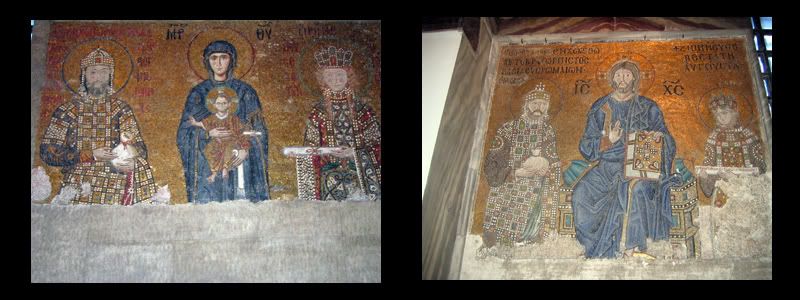
As iconoclastic Islam forbids the depiction of living creatures, the ornate mosaics were plastered over. The altar was torn out, the pulpit replaced with a mimbar, the bells removed and washing facilities installed outside.
Four minarets were added at the corners of the building, and the crumbling walls were buttressed in the 16th Century.
The Sophia’s use continues to be linked to the religious stance of its political masters. Turkey became a secular republic in 1923, and 12 years later head-of-state Mustafa Kemal, ordered it turned into a museum. Who knows to what use it will next be turned.
Since it has been a museum, much of the Ottoman plasterwork has been stripped away, revealing the stunning mosaics which had been hidden for five hundred years.
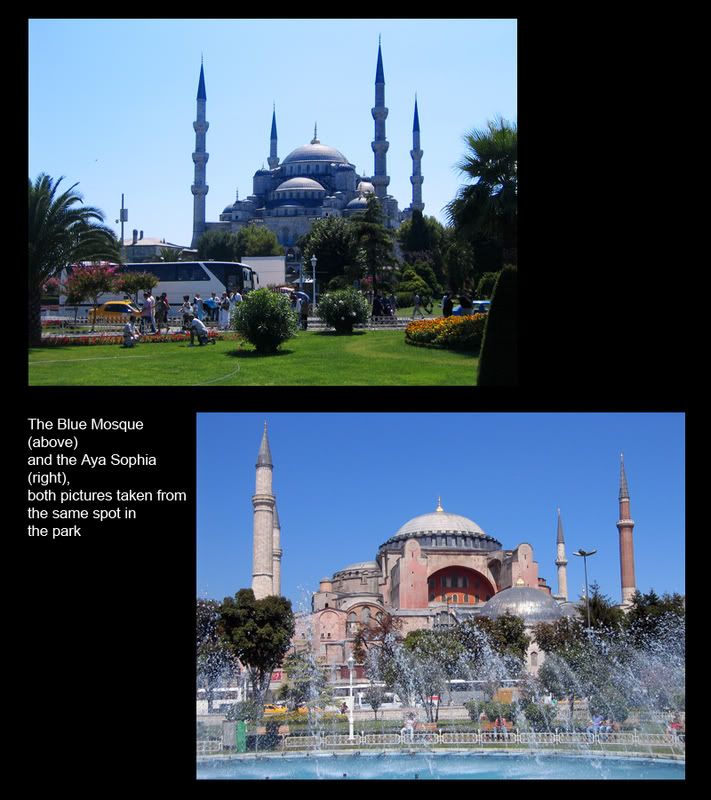
Aya Sophia is faced across Sultanmet Park by the Blue Mosque, built on the orders of Sultan Ahmed, and also known as the Sultan Ahmed Mosque. Completed in 161, it was built as a rival to the Aya Sophia by a sultan who had failed to win any notable military victories and hoped to placate Allah with a spectacular church.
The two giant buildings flank the park, a stunning site, and strolling along the path I could feel the historical weight of the kings, emperors and sultans who had gone before me.
As the Blue Mosque still serves the community it is closed to visitors at prayer time. It being close to five, when the city explodes with the distinctly Islamic melodies of the call to prayer, I headed there first.
In my mind there is little doubt that the Blue Mosque has a more visually stunning exterior than the Aya Sophia, with its arrow-like spires rising to pleasing points and its core bubbling up in half domes to the perfectly formed central bulb.
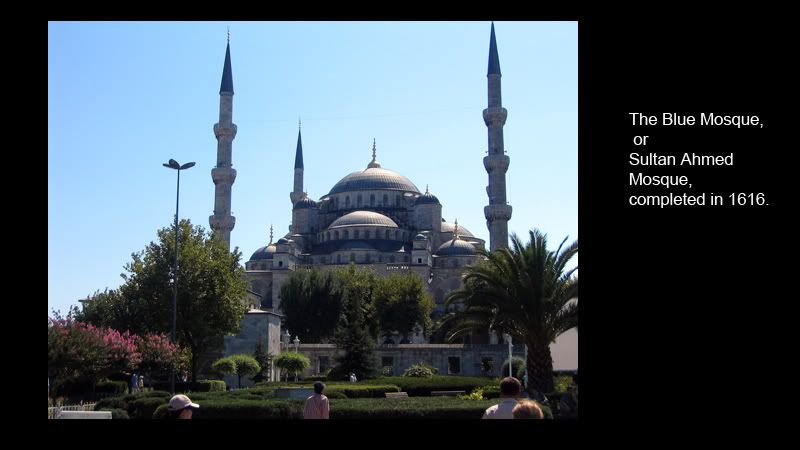
The courtyard, with identical dimensions to the interior, is paved with giant but uneven stone slabs. The August sun was baking, tugging at my exposed shoulders, the only respite the shaded perimeter, unfortunately occupied by screaming kids and shushing mothers.
To add to the sacrilegious feel of tantruming infants, a large official looking Turk shouted “Entrance other side” in at least half a dozen languages.
I put my flip flops in a plastic bag to carry through the mosque, rolled my shorts down over my knees and was asked to wear a greasy aquamarine shawl to cover my shoulders.
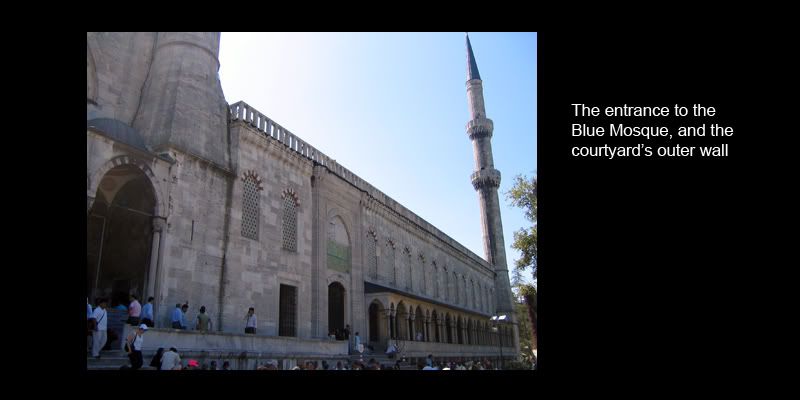
It’s certainly tall inside. Four giant, rather graceless, grey pillars support the huge dome, but, unlike the exterior, there is little elegance about the interior geometry. The sheer scale of the thick-set arches and columns leave little illusions as to how the dome is supported.
The mosaics are pretty, but not awe inspiringly intricate. The gold leaf altar is small in contrast to the rest of the building, and slightly garish.

The smell of feet wafted through the air with the cries and stamps of children who threw hissy fits in the manner of the spoilt – lying face down on the floor, sobbing and bashing the ground with their fists until their parents withdrew the silent treatment and scooped them up for a pampering.
Strolling the short walk across the park to the older Aya Sophia it is clear that fifteen hundred years have not been kind to the building. War, conquest, defeat, riot, fire, earthquakes and religions have left their scars on the Sixth Century structure.
It cannot boast the same elegant exterior as the Blue Mosque. The minarets, mismatched after earthquakes forced rebuilding throughout the centuries, are chubbier, less gravity defying and rise to a blunter point. The main dome bears none of the exterior elegance of its opponent, clearly being supported by buttresses, and the flaky remains of the brick colour paint leave it looking washed out and sun baked, unlike the cool greys and blues of the Blue Mosque.
The excavated remains of the original St Sophia church (404-415) sit outside the entrance, and that too must have been impressive until destroyed by a riot. Much of the recovered stonework bears striking Christian crosses.

Inside, the Sophia’s dome rises to a neck-craning height, its giant diameter supported subtly and gracefully by half domes on two-sides and arching walls on the others.
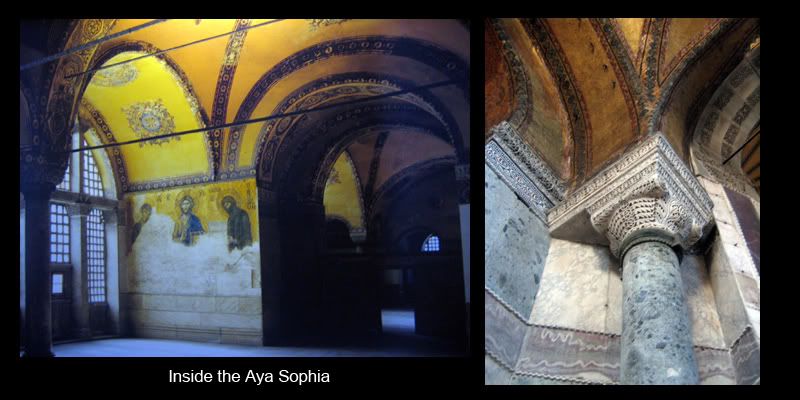
The walls are polished granite and marble of such exquisite natural beauty they belie the need for mosaic or painting until the upper echelons of the building, which are now mostly painted in the flowery Arabic geometry.

Admittedly the restoration work obscures some of the buildings scale – the cavernous 55m tall interior dominated by scaffolding. Back in the 6th Century it must have been beyond belief that such a space could be covered so elegantly, when finished it had the biggest dome in the world.
A millennia and a half of feet have left the paving slabs polished, but cracked and splintered, often into tiny pieces.
The solemn stone still seems to echo the millions who have worshipped here. The newly exposed mosaics look fresh and bright, despite being under plaster for so long.
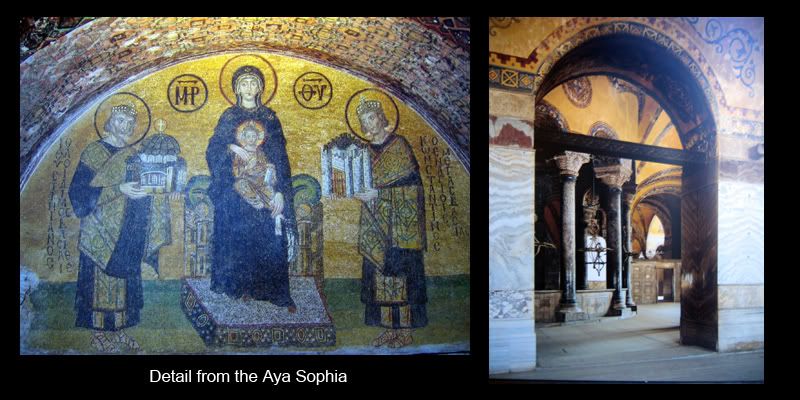
I regret my camera could not do the place justice. So I cheekily snapped a few photographs that were on display in the gallery.
Ends
mrdanmurdoch@gmail.com


No comments:
Post a Comment